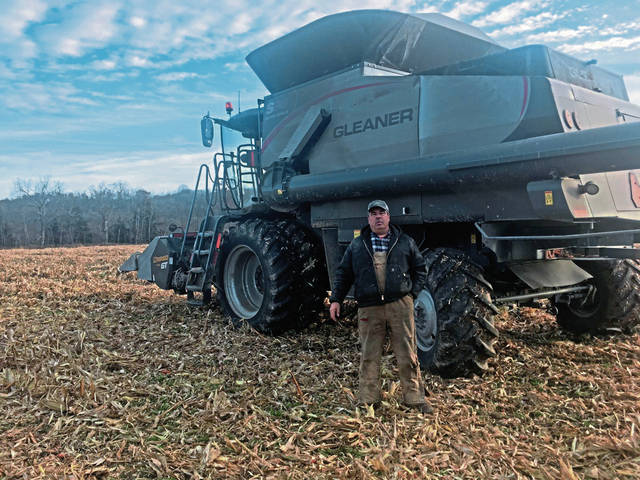High-tech equipment, land leasing, age-old practices keep today's farmers growing
By looking at a computer screen in his new $500,000 combine, Andrew Kimmel knew his yield was about 225 bushels-per-acre of feed corn for one of the Burrell Township fields he was harvesting Thursday afternoon.
It’s harvest time, modern style.
On Thursday, Kimmel climbed a six-rung, steel ladder to reach the cab of his AGCO Gleaner harvesting combine. It’s the size of a small tank, with two computer screens displaying a GPS-generated image of the field he is harvesting and a camera view displaying the back of his vehicle where kernels of corn magically pile up.
The harvester quickly devours a sea of eight-foot high corn stocks and winnows out the golden grains. Its hulking appearance, with six missile-shaped steel cones that straighten the stocks and pull the ears into the combine is startling to see, rivaling the handiwork of an alien crop circle.
And that’s just the harvesting.
Kimmel buy his seeds from Corteva Inc. The company offers satellite imagery that aids crop quality reports detecting when, say, the corn is stressed by too much rain or insects.
“When you see the corn, it can look green and good,” he said. “But with the satellite information, you can see the stressors and then act to correct problems.”
Still, there’s much tradition with Kimmel, 50, of Shelocta, being a fourth generation farmer who wears weathered overalls in the cold and flashes an easy smile.
Some things don’t change with a late fall harvest — that no matter how sophisticated the combine, any farmer has to wait until the morning dew dries before hitting the field. For Kimmel in Burrell Township this week, that’s a starting time of 10 a.m.
Kimmel grows corn and soy beans on 1,800 acres throughout Armstrong and Indiana counties, some owned by his family’s Creekland Farms Inc. and some leased.
This week, he’s harvesting feed corn, including some owned by the Bruces, whose families have owned the land in Burrell Township since 1807.
These fields have come a long way since they were tilled by Suzanne Bruce’s grandfather, the “Potato King” in the early 20th century.
Without leaving the seat of his combine, Kimmel can tell you that that the corn he was harvesting Thursday has a moisture content of near 20% and how the swine flu in China is impacting the international grain market.
He has a degree from Penn State University in agriculture economics and rural sociology. Kimmel brings technology to his fields that his land leasees such as the Bruces can’t.
Edgar and Suzanne Bruce, both 85, grew up as neighbors, then young sweethearts who reunited later in life, married and settled down in Penn State’s Happy Valley and Suzanne’s family homestead in Burrell Township. The couple, along with Judith Ann Rogan, own 100 acres.
But the Bruces are not farmers. Never were.
Sure, they helped out at their family farms growing up, but both went on to pursue other professions.
Leasing the land for farming was their best option, plus preserving it: The Bruce’s Woak-Hanne Farm is a recognized Pennsylvania Bicentennial Farm permanently protected by development by the Armstrong County Agricultural Land Preservation Program.
Edgar Bruce, a retired aerospace engineer from Penn State who worked on propulsion for nuclear submarines, said of Kimmel’s method of farming: “It’s as high-tech as engineering.”
As a youngster, Bruce did help on the family farm, using a corn binder to cut and harvest the corn that was then loaded onto a horse-drawn wagon and unloaded in the barn. They had to wait for someone to bring a thrasher machine to separate the corn.
“You have to know what you are doing to be successful in farming,” he said.
Suzanne Bruce said she feels blessed to have Kimmel and to be able to keep their multigenerational farm still operating.
“We love the land and our ancestry,” she said. “Nothing is more beautiful than the sight of the field in late summer when it is bathed in the glow of the setting sun.”
Remove the ads from your TribLIVE reading experience but still support the journalists who create the content with TribLIVE Ad-Free.


